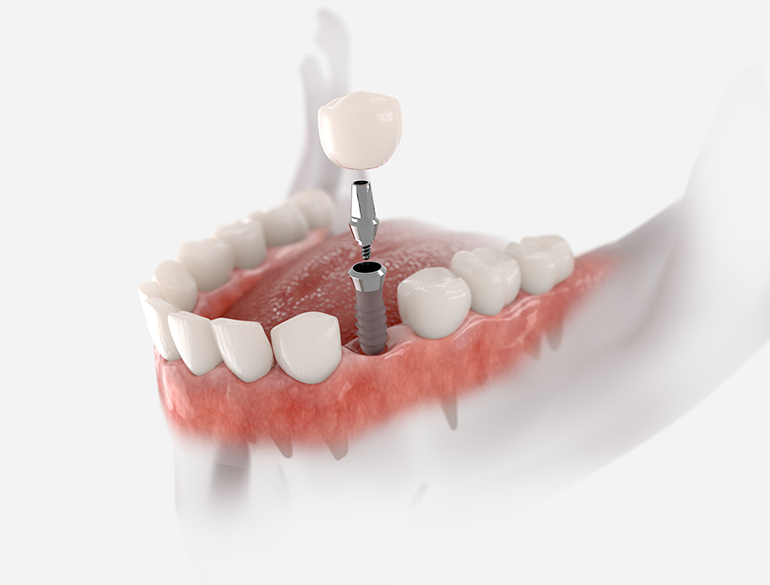Rumored Buzz on Dental Sense
Rumored Buzz on Dental Sense
Blog Article
See This Report on Dental Sense
Table of ContentsThings about Dental SenseThe Dental Sense IdeasThe Main Principles Of Dental Sense 7 Easy Facts About Dental Sense Shown
are medical gadgets surgically dental implanted into the jaw to bring back an individual's capacity to eat or their look. They give support for synthetic (fake) teeth, such as crowns, bridges, or dentures. When a tooth is lost because of injury or disease, an individual can experience issues such as quick bone loss, malfunctioning speech, or modifications to eating patterns that cause discomfort.Oral dental implant systems contain an oral implant body and oral implant abutment and may also include a joint fixation screw. Kids dental. The oral implant body is surgically placed in the jawbone in location of the tooth's root. The dental implant abutment is typically affixed to the implant body by the abutment fixation screw and expands with periodontals into the mouth to sustain the attached man-made teeth
(https://go.bubbl.us/e7bebd/a315?/Dental-Sense)Structure of The Dental Implant System selecting oral implants, talk with your oral provider about the potential advantages and dangers, and whether you are a candidate for the treatment. Points to take into consideration: Your general health is an important aspect in identifying whether you are a good candidate for dental implants, how much time it will take to recover, and the length of time the dental implant might stay in area.
Smoking may impact the recovery process and lower the long-term success of the implant. The recovery procedure for the implant body may take a number of months or longer, throughout which time you generally have a momentary joint instead of the tooth. the dental implant procedure: Meticulously comply with the oral health directions provided to you by your oral supplier.
Little Known Questions About Dental Sense.
Implant failing can lead to the demand for an additional surgery to fix or change the dental implant system. Recovers the ability to eat Brings back aesthetic look Assists keep the jawbone from diminishing because of bone loss Protects the health of the bordering bone and gums Aids maintain surrounding (nearby) teeth stable Enhances high quality of life Damages to surrounding natural teeth during implant placement Injury to the surrounding cells throughout surgical procedure, such as sinus perforation Injury throughout surgical treatment (for instance, crack of surrounding jawbone) Inadequate feature, such as really feeling like the teeth do not attack together usually An experience that the tooth hangs or twisting in position arising from an abutment screw loosening Implant body failure (looseness of the implant body) because of systemic infection, which may be more probable in individuals with uncontrolled diabetics issues as a result of neighborhood infection in bone and gums supporting the dental implant body as a result of delayed recovery, which might be more probable in individuals that smoke Difficulty cleansing the gum tissues around the dental implant, resulting in bad oral hygiene Unattended periodontal condition Post-surgical feeling numb due to nerve impingement or damage Always inform healthcare companies and imaging professionals that you have oral implants before any kind of magnetic vibration imaging (MRI) or x-ray treatments.
FDA is not knowledgeable about any negative occasions reported for MRI or x-ray treatments with oral implants. Oral implants systems are typically made from products that adhere to international agreement criteria of the International Organization for Standardization (ISO) or ASTM International. These requirements have information of what makes a secure material.

An oral implant is a framework that replaces a missing tooth. With screw-like tools, the doctor inserts an implant right into the jawbone, and it works as an anchor for an artificial tooth, called a crown. A device called a joint attaches the fabricated tooth to the dental implant. The crown is customized to fit the individual's mouth and match the color of their teeth.
The Facts About Dental Sense Uncovered
Some people are not qualified for dental implant surgical treatment. It is for dental doctors to operate on people with: severe illnessuncontrollable metabolic diseasebone or soft cells disease or infectionIf these problems are dealt with, a person can have the surgery. In, oral cosmetic surgeons avoid operating people with: If people with any one of the above undergo dental implant surgery, there is a higher risk of the implant failing.

Oral dental implant surgical procedure is a tailored procedure. Provide you time to recover. Affix the blog post and final crown, bridge or denture.
Next, your specialist will meticulously place the oral implant right into your jaw. Your doctor will rearrange your gums and close the incision with stitches. this page If your dental implant is near the front of your mouth, your dental practitioner will certainly make a momentary tooth for you to wear up until you recover. That way, you won't have a gap in your smile while you recoup.
5 Simple Techniques For Dental Sense
Your service provider can inform you what to anticipate in your circumstance. During the healing phase, your jawbone must fuse to the dental implant. This procedure, called osseointegration, is important for security and lasting success. This procedure can take anywhere from three to 9 months. Sometimes, it might take longer.
Once your dental implant heals, your dentist can connect the abutment (small connector blog post) and your last reconstruction (crown, bridge or denture). This generally takes regarding one hour to finish and may call for a second small surgical treatment. You should not feel any discomfort during your dental implant treatment since your supplier will certainly use medicine to numb your gums.
Report this page